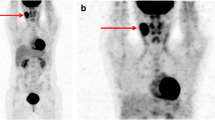Abstract
Objective
Although18F-fluorodeoxyglucose (FDG) positron emission tomography (PET) has been used as a promising tool to diagnose primary central nervous system lymphoma (PCNSL) because the tumor shows very high FDG accumulation, no data exist evaluating the extent of tumor FDG transport and metabolism. The aim of this study was to evaluate the feasibility of FDG-PET kinetic analysis in measurement of uptake parameters of FDG in the lymphoma tissues and in the assessment of treatment effects in patients with PCNSL.
Methods
Dynamic FDG-PET examination was performed in 7 histologically proven PCNSL patients before and after methotrexate-based chemotherapy.
Results
Before the chemotherapy, the highest CMRglc in the tumor for all 7 patients was 79.4 ± 27.2 μmol/100 g/min. This value was significantly higher than that observed in the normal cortex in 14 control patients (44.3 ± 6.0 μmol/100 g/min, p < 0.001). The phosphorylation (k3) activity was also significantly higher in the tumor (0.093 ± 0.026 min-1) compared with the normal cortex (0.064 ± 0.014 min-1, p < 0.05). On the other hand, the transporter (K1) activity in the tumor (0.079 ±0.016 ml/min) was similar to that observed in the normal cortex (0.082 ± 0.012 ml/min). The chemotherapy significantly reduced the volume of the tumor in 6 of 7 patients and the highest CMRglc in the tumor examined 18.0 ± 5.5 days after the chemotherapy (34.0 ±21.8 μmol/ 100 g/min) was significantly lower than that observed before the chemotherapy (p < 0.01). This reduction in FDG uptake was concomitant with a significant reduction in both the K1 and k3 values (p < 0.05). The reduction in the k3 value after the chemotherapy was marked in 6 of 7 patients in whom the tumor responded to the first chemotherapy.
Conclusions
Dynamic image acquisition can separate regional FDG uptake into FDG transport and phosphorylation activity in the lymphoma tissues. Tumor FDG uptake was significantly higher with accelerated phosphorylation activity compared with that observed in the normal cortex.
Similar content being viewed by others
Reference
Corn BW, Marcus SM, Tophan A, Hauck W, Curran WJ Jr. Will primary central nervous system lymphoma be the most frequent brain tumor diagnosed in 2000?Cancer 1997; 79:2409–2413.
Roelcke U, Leenders KL. Positron emission tomography in patients with primary CNS lymphomas.J Neuro-Oncol 1999; 43:231–236.
Rosenfeld SS, Hoffman JM, Coleman RE, Glantz MJ, Hanson MW, Schold SC. Studies of primary central nervous system lymphoma with fluorine-18-fluorode-oxyglucose positron emission tomography.J Nucl Med 1992; 33:532–536.
Wong K-P, Feng D, Meikle SR, Fulham MJ. Validation of noninvasive quantification technique for neurologic FDG-PET studies. In:Phisiological imaging of the brain with PET, Gjedde A, Hansen SB, Kundsen GM, Paulson OB (eds), San Diego; Academic Press, 2001: 121–125.
Schaller B. Usefulness of positron emission tomography in diagnosis and treatment follow-up of brain tumors.Neurobiol Dis 2004; 15:437–448.
Spence AM, Muzi M, Graham MM, O’Sullivan F, Krohn KA, Link JM, et al. Glucose metabolism in human malignant gliomas measured quantitatively with PET, 1-[C-l l]glucose and FDG: analysis of the FDG lumped constant.J Nucl Med 1998; 39:440–448.
Herholz K, Rudolf J, Heiss WD. FDG transport and phosphorylation in human gliomas measured with dynamic PET.J Neuro-Oncol 1992; 12:159–165.
Hoekstra OS, Ossenkoppele GJ, Golding R, van Lingen A, Visser GW, Teule GJ, et al. Early treatment response in malignant lymphoma, as determined by planar fluorine-18-fluorodeoxyglucose scintigraphy.J Nucl Med 1993; 34:1706–1710.
Romer W, Hanauske A-R, Ziegler S, Thodtmann R, Weber W, Fuchs C, et al. Positron emission tomography in non-Hodgkin’s lymphoma: assessment of chemotherapy with fluorodeoxyglucose.Blood 1998; 91:4464–4471.
Yamane T, Daimaru O, Ito S, Yoshiya K, Nagata T, Ito S, et al. Decreases18F-FDG uptake 1 day after initiation of chemotherapy for malignant lymphoma.J Nucl Med 2004; 45:1838–1842.
Ogawa T, Kanno I, Hatazawa J, Inugami A, Fujita H, Shimosegawa E, et al. Methionine PET for follow-up of radiation therapy of primary lymphoma of the brain.Radiographics 1994; 14:101–110.
Kim L, Hochberg FH, Shaeffer P. White-matter abnormalities in unirradiated patients cured of primary central nervous system lymphoma.Neuroradiology 2000; 42:406–412.
Villringer K, Jager H, Dichgans M, Ziegler S, Poppinger J, Herz M, et al. Differential diagnosis of CNS lesions in AIDS patients by FDG-PET.J Comput Assist Tomogr 1995; 19:532–536.
Author information
Authors and Affiliations
Corresponding author
Rights and permissions
About this article
Cite this article
Kawai, N., Miyake, K., Tamiya, T. et al. Evaluation of tumor FDG transport and metabolism in primary central nervous system lymphoma using [18F]fluorodeoxyglucose (FDG) positron emission tomography (PET) kinetic analysis. Ann Nucl Med 19, 685–690 (2005). https://doi.org/10.1007/BF02985117
Received:
Accepted:
Issue Date:
DOI: https://doi.org/10.1007/BF02985117




